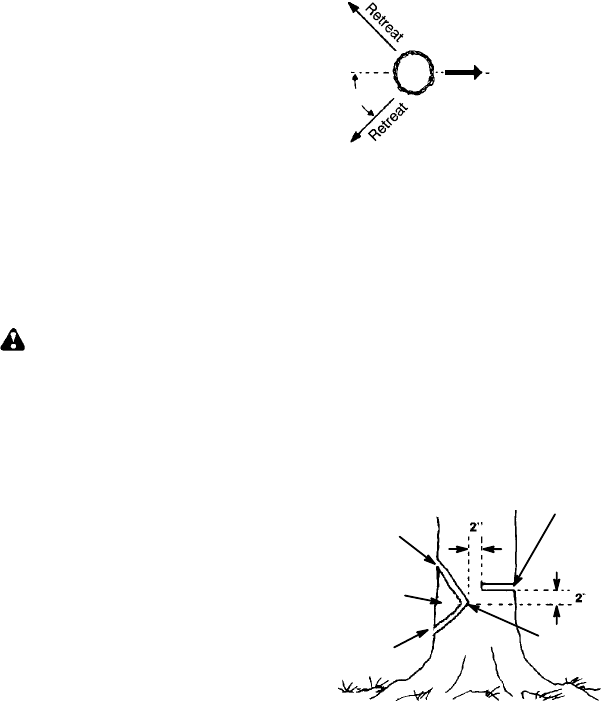
11
S Keep the chain out of dirt and sand. Even a
small amount of dirt will quickly dull a chain
andthus increase thepossibility of kickback.
S Practice cutting a few small lo gs using the
following techniques to get the“feel” ofus-
ing your saw before you begin a major
sawing operation.
S Squeeze the throttle trigger and allow
the engine to reach full speed before
cutting.
S Begin cutting with the saw f rame
against the log.
S Keepthe engine at fullspeed theentire
time you are cutting.
S Allowthechaintocutfor you.Exertonly
light downward pressure. If you force
thecut, damagetothe bar,chain, oren-
gine can result.
S Release the throttle trigger as soon as
the cut is completed, allowing the en-
gine to idle. If you run the saw at full
throttle withouta cuttingload,unneces-
sary wear can occur to the chain, bar,
and engine. It is recommended that
the engine not be operated for lon-
ger than 30 seconds at full throttle.
S Toavoidlosingcontrolwhencut i scom-
plete,donotputpressureonsaw a tend
of cut.
S Stop the engine before setting the saw
down a fter cutting.
TREE FELLING TECHNIQUES
WARNING: Check for broken or
dead branches which can fall while cutting
causing serious injury. Do notcut nearbuild-
ings orelectrical wires ifyou donot know the
directionof treefall, norcutatnight sinceyou
will not be ale to see well, nor during bad
weather such asrain, snow,or strongwinds,
etc. If thetree ma kes contact with any utility
line, the utility company should be notified
immediately .
S Carefullyplanyour sawingoperation inad-
vance.
S Clearthework a rea. You needa cleararea
allaround thetree so youcan have secure
footing.
S The chain saw operator should keep on
the uphill side of the terrain as the tree is
likely torollorslidedownhill afteritisfelled.
S Study the n atural conditio ns that can cause
the tree to fall in a particular direction.
Natural conditions that can cause a tree to
fall in a particular direction include:
S The wind direction and speed.
S The lean of the tree. The lean of a tree
might not be apparent due to uneven or
sloping terrain. Usea plum bor level tode-
termine the direction of tree lean.
S Weight and branches on one side.
S Surrounding trees and obstacles.
Look for decay and rot. If the t runk isrotted,
it can snap and fall toward the operator.
Check for broken or dead branches which
can fall on you while cutting.
Make sure there is enough room for t he tree to
fall. Maintain a distance of
2-1/2 tree lengths
from the nearest person o r other objects. En-
gine noise can drown out a warning call.
Remove dirt, stones, loose bark, nails, sta-
ples, andwire fromthetreewherecuts areto
be made.
Plana clear retreat pathto therear anddiag-
onal to the line of fall.
Direction of Fall
45_
Plan a clear retreat path
FELLING LARGE TREES
(6 inches (15 cm) in diameter or larger)
The notch method is used to fell large trees.
Anotch iscut o nthesideofthetreeinthede-
sired direction of fall. After a felling cut i s
made on the opposite side of tree, the tree
will tend to fall into the notch.
NOTE: If the tree has large buttress roots,
removethem beforemaking t henotch. If us-
ing saw t o remove buttress roots, keep saw
chain fromcontacting groundtopreventdull-
ing of the chain.
NOTCH CUT AND FELLING THE
TREE
S Make notch cut by cutting the top of the
notch first. Cut through
1/3 of the diameter
ofthetree. Nextcomplete t henotchby cut-
ting the bottom of the notch. See illustra-
tion. Once the notch is cut remove the
notch of wood from the tree.
Notch
First cut
Second cut
Final (felling) cut here, 2 i n ches
(5 cm) above center of notch.
Hinge
S After removing the wood from the notch,
make the felling cut on the opposite side of
thenotch. This isdone bymaking acut about
two inches (5 cm) higher than the center of
the notch. This will leave e nough uncut wood
between t he felling cut and the notch to form
a hinge. This h inge will help prevent th e tree
from falling in the wrong direction.


















